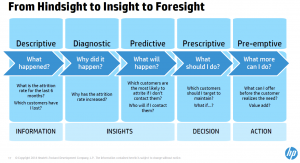A presentation last week, hosted by Database Trends and Applications (DBTA), was a great example of some interesting technical information presented poorly. As that sentence implies, this column is one about the marketing of business intelligence (BI), not about the technology – well, not much…
There were three presenters: Brian Bulkowski, CTO and Co-founder, Aerospike; Kevin Petrie, Senior Director and Technology Evangelist, Attunity; Reiner Kappenberger, Global Product Management, HPE Security – Data Security.
Aerospike
Brian was first at the podium. Aerospike is a company providing what they claim is a very high speed, scalable database, proudly advertising “NoSQL!” The problem they have is that they are one of many companies still confused about the difference between databases and SQL. A database is not the access method. What they’re really focused on in loosely structured data, the same way Hadoop and other newer databases are aimed. That doesn’t obviate the need to communicate via SQL.
He also said that the operational in-memory market is “owned by NoSQL.” However, there were no numbers. Standard RDBMS’s, columnar and NoSQL databases all are providing in-memory storage and processing. In fact, Information Management has a slide show of Gartner’s database analytics vendor report and you can see the breadth there. In addition, what I constantly hear (not statistically significant either…) is that Hadoop and other loosely-structured databases are still primarily for batch. However, as the slide show I just mentioned is in alphabetical order, and Aerospike is the first one you’ll see. Note again that I’m pointing out flaws in the marketing message, not the products. They could have a great in-memory solution, but that’s doesn’t mean NoSQL is the only NoSQL option.
The final key marketing issue is that he kept misusing “transactional.” He continued to talk about RDMS’s as transactional systems even while he talked about the power of Aerospike for better handling the transactions. In the later portion of his presentation, he was trying to say that RDBMS’s still had a place, but he was using the wrong term.
Attunity
Attunity’s Kevin Petrie was second and his focus was on Attunity Replicate. The team of Aerospike and Attunity again shows the market isn’t yet mature enough to have ETL and databases come smoothly together. Kevin talked about their 35 sources and it seem that they are the front end in the marketing paring of the two companies. If you really need heterogeneous data sources and large database manipulation, you’ll need to look at the pair of companies.
My key issue with this section was one of enterprise priorities. Perhaps the one big, anonymous reference they both discussed drove the webinar, but it shouldn’t have owned the message. Mr. Petrie spent almost all his time talking about Hadoop, MongoDB and Kafka. Those are still bleeding edge tools while enterprise adoption requires a focus on integrating with standard and existing sources. Only at the end, his third anonymous case, did Kevin have a slide that mentioned RDBMS sources. If he wants to keep talking with people running experimental and leading edge tests of systems, that priority makes sense. If he wishes to talk to the larger enterprise market, he needs to turn things around.
The other issue was a slide that equated RDBMS, Data Warehouse and Hadoop as being on equal footing. There he shows a lack of business knowledge. The EDW, as an old TV would declare, is the one of these things that is not like the other. It has a very different purpose from the two database technologies and isn’t technology dependent.
HPE Security
Reiner Kappenberger gave a great presentation but it didn’t belong. It seems the smaller two firms were happy to get HP to help with the financing but they didn’t think about staying on message.
Let me make it very clear: Security is of critical importance. What Mr. Kappenberger had to say was very important for people to hear. However, it didn’t belong in this webinar. The topic didn’t fit and working to stuff three presenters into forty minutes is always tough. Another presentation where all three talked about how they work to ensure that the large volumes of data can be secure at multiple levels would have been great to hear – and I hope the three choose to create such a webinar.
Summary
This was two different webinars stuffed into one, blurring the message. In addition, Aerospike and Affinity either need to make sure they they’re not yet trying to address the mass market or they need to learn how to stop speaking to each other and other leading edge people and begin to better address the wider enterprise market.
The unnamed reference seemed to be a company that needed help with credit card transactions and fraud detection, and all three companies worked to provide a full solution. However, from a marketing standpoint I don’t think they did proper service to their project by this webinar.
